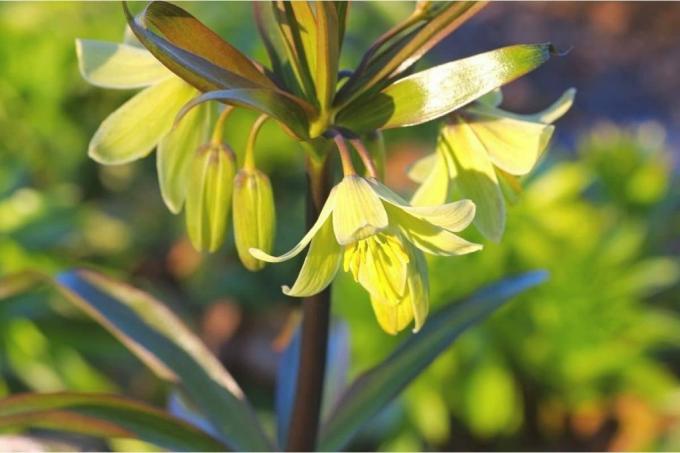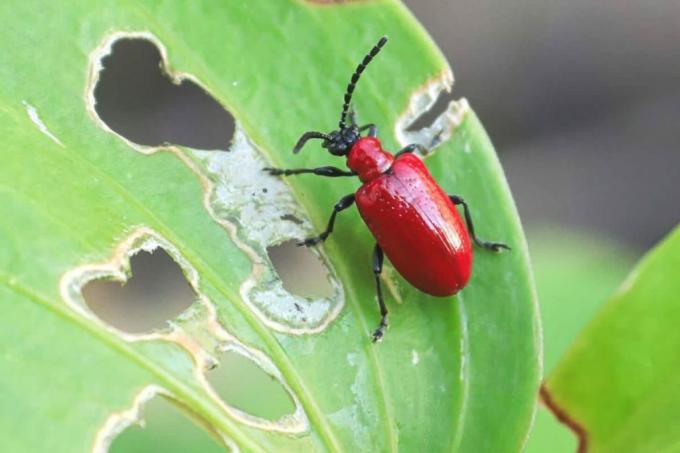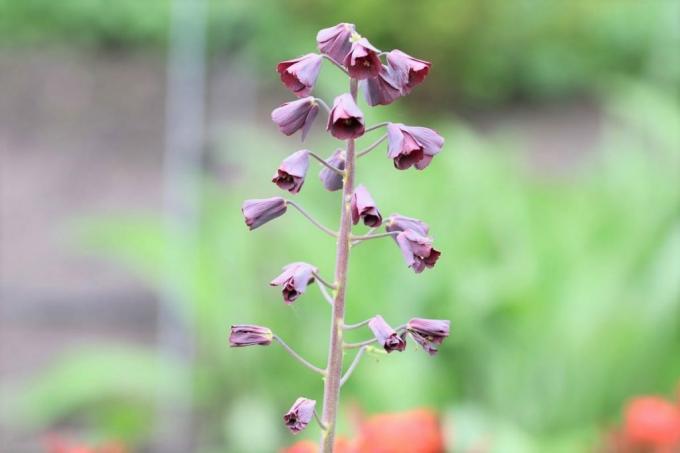
table of contents
- Flowering time and flowering
- Soil condition and location
- Fertilizing and watering
- Diseases and pests
- Bucket cultivation
- plants
- Cut
- Overwinter
- Multiply
- frequently asked Questions
Profile and care information open +conclude -
- Flower color
- yellow, purple, green, brown, blue
- Location
- Partial shade, sunny, full sun
- Heyday
- April May
- Growth habit
- upright, perennial, clump-forming, perennial
- height
- up to 100 centimeters
- Soil type
- sandy, loamy
- Soil moisture
- moderately dry, fresh
- PH value
- neutral, weakly alkaline
- Limescale tolerance
- Calcium tolerant
- humus
- rich in humus
- Poisonous
- Yes
- Plant families
- Lily family, Liliaceae
- Plant species
- Border flowers, perennials, ornamental plants, bulb flowers
- Garden style
- Perennial garden, rock garden
The sophisticated Persian Imperial Crown unfortunately also requires a lot of maintenance. However, it offers a visual highlight in every garden with its beautiful blossom. If you follow our instructions for care, nothing stands in the way of abundant flowering.
Flowering time and flowering
The abundant flowering of the plant, which originally comes from the Middle East, begins with the appropriate care in April and lasts until May. Here the Persian imperial crown enchants with a flower in a decorative plum-blue color, very different from its yellow relatives. It gives off a sweet scent during flowering.
Tip: The blooming stems of the Persian Imperial Crowns are also used as cut flowers. For the vase you should cut it at the base while it is still in bloom or in bud.
Soil condition and location
In their homeland, the Persian Imperial Crown thrives in sunny locations up to 2500 meters above sea level. The location of the warmth-loving plant must therefore also be chosen accordingly. Because in shady, cool places there will be no decorative blooms. Therefore, you should always choose a sunny place in the garden that can meet the requirements of the graceful plant:

- a sunny front or rock garden
- a flower bed in front of the south side of the house
- sheltered from the wind
- Otherwise the flower stalks could kink
- use discounts to protect against buckling
- Soil permeable and warm
- possibly add sand for permeability
- nutrient-rich and humus
- Fold in compost before first planting
Tip: When using compost, it is advisable to lift it under the existing soil in the garden bed about two months before the onions of Fritillaria persica are set. So it can decompose well and deliver the released nutrients to the plants right from the first day.
Fertilizing and watering
The Persian Imperial Crown can withstand a few days of drought rather than being too wet. Therefore, you should only water the plant moderately. A rainy spring can therefore also damage the flower. In such a case, sometimes it makes more sense to grow the decorative plant in a tub:
- pour little
- when the soil is completely dry
- Check container plants for this more often
- fertilize regularly
- both in autumn
- also in the spring before and during budding
- compost is ideal
- in the bucket liquid fertilizer for bulb flowers
Diseases and pests
There are no known diseases in Fritillaria persica. But since it is a plant from the lily family (Liliaceae), incorrect care can lead to an infestation of Lily Chicken (Lilioceris lilii) come, which can cause a lot of damage to the decorative plants.

The pests are easy to spot:
- glowing red sign
- black legs and head
- From March onwards they feed on flowers, leaves and shoots
- leave large damage to eat up to baldness
- both adults and larvae
By collecting early in the morning, both the beetles and the larvae can be removed. The plants can then be cleaned well with a jet of water. In the event of a severe infestation, however, only the use of insecticides can help. A near-natural garden with many Birds and Hedgehogsthat are considered natural enemies can prevent infestation.
Bucket cultivation
The Persian Imperial Crown can also be cultivated in a tub. This can be the case when there is no garden available and the bucket is placed on a terrace or balcony that is suitable for the location. But climatic conditions in your own residential area can also play a role here. In a rainy spring or a very cold winter, container cultivation on a sheltered balcony or terrace can be more successful:
- choose large, wide tubs
- put several onion plants together
- Place drainage on the drainage hole
- Use gravel or pottery shards
- place plant fleece over this
- Fill in prepared soil
- Garden soil mixed with compost
- alternatively potting soil from the trade
- Place the onions at a distance of 25 centimeters
- water well
The pot can be placed in a sunny, roofed corner protected from the wind. The roof can also be omitted on warm and very sunny days. It is important that the plants do not get too much moisture from falling rain.
plants
The Persian Imperial Crown is placed in the ground in autumn so that it can unfold its full splendor in the garden bed in early spring. The ideal planting time is September so that the bulbs can grow well:

- Use by October at the latest
- before frost comes
- Plant holes at a distance of 25 centimeters
- Planting depth about 15 centimeters
- add some fertilization now
- Create drainage against waterlogging
- Put gravel on the bottom of the planting hole
- Put in onions
- Fill in soil
- water well
Tip: After the plant has withered and the leaves have turned yellow, you can remove the bulbs from the ground. These are stored in a warm and dry place. An ambient temperature of 25 degrees Celsius is ideal. In September the bulbs are put back into the ground.
Cut
Under no circumstances should the Persian Imperial Crown be cut when it has faded. Because then it may not sprout and bloom at all or only very sparsely in the next year. It is better to leave the leaves as well as the withered stem on the plant:
- Leaves turn yellow
- fall to the ground by themselves
- also withered stem
- The leaves and stems dry up
- This is where the onion draws its nutrients
- are required for the next budding
- Sheets can then simply be peeled off
Overwinter
The onions of the Persian Imperial Crown are usually hardy. However, it can happen that the plants begin to sprout in a warm autumn / winter. Both these and the Fritillaria persica cultivated in a tub should receive a little protection before the coming winter:

- Mulching the garden bed
- alternatively cover with brushwood mats
- protects onions from frost and drying out
- remove early in late winter
- otherwise the plant will be prevented from sprouting
- Cover the bucket with brushwood, straw or coconut mats
- Mulch earth here too
- spend in a sheltered corner
- Place on a piece of wood or styrofoam
- so no frost gets into the bucket from below
Multiply
Bulb flowers usually form small bulbs around the mother onion. These are simply separated when they are removed from the ground in early summer and can be given their own location next autumn. However, they will likely remain smaller in the first year of standing and may not bloom either. But in the second year the new bulbs will reach the same size as the mother onions:
- Remove the onions from the earth
- either in early summer
- in the case of onions that remain in the ground in autumn
- Carefully separate the small onions
- store separately
- when the onions are removed in early summer
- or put directly back into the ground
- then it can be multiplied in autumn

frequently asked Questions
In this case, repotting is not necessary, because you can remove the bulb from the pot after flowering and the leaves have been drawn in and store it in a warm and dry place. So you can prepare the bucket with fresh earth again in autumn.
Yes, unfortunately the graceful plant is poisonous in all parts. Therefore, consider cultivating if your household has small children or free-range pets.
It is an onion flower. These have the property that they draw in the nutrients for the next shoot from the old leaves. The leaves turn yellow and limp. Once the feed is complete, the sheets can easily be pulled off without pressure. The extracted nutrients are stored in the onion for the next year.
For ideal care, it is advisable to remove the bulbs of the Persian Imperial Crown from the ground and only use them again in autumn. However, if you live in a warm and dry climate or you can cultivate it in a tub Put this under a protective roof, then the onions can also be in the ground remain. However, it should stay dry. A rainy summer makes them rot in the ground.


